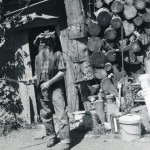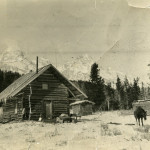Jimmy Manges originally homesteaded the land that became the Elbo Ranch, just south of Jenny Lake. He applied for a patent in 1911, and it took him seven long years of hard work to clear just 42 of his 160 acres. The homestead cabin he built in 1911 became one of the first homesteads on the west side of the Snake River, and one of the first cabins in the valley to have a second floor. The cabin also featured a “basement” in the form of a root cellar. Manges’ design was intended to make full use of the stove downstairs to heat the bedroom upstairs. In 1918 he received his patent and continued to work his poor soil, also working for several area dude ranches as a pack trip guide. By 1926 when he was approached by California businessman Chester Goss to sell, Manges quickly agreed to the sale. At the same time he was approached by Joseph Clark and Frank Williams who were looking to develop their own ranch, and Manges sold them 40 acres. Keeping 4.9 acres on which to live, Goss received the other 115 to develop the Elbo Ranch.
With some cash in his pocket, and the pressures of carving out a living from his land relieved, Manges was able to retire somewhat, ironically into the tourist business. Manges built himself a new homestead on his 4.9 acre parcel, and kept odd jobs around the valley as a laborer. In the 1930s, families were arriving in the valley having heard of the natural beauty and abundant wildlife. For those who couldn’t afford the expensive dude ranches, many resorted to camping along the roadside. One summer, Manges allowed a family to camp on his land rather than in the exposed sage flats. They built a small, crude cabin that they returned to the next summer. When the Civilian Conservation Corps (CCC) arrived in 1933 at nearby Jenny Lake, the foreman found affordable and affable housing with Manges for their families. They were allowed to build small rustic cabins, which they later turned over to Manges upon their departure.
With the absence of the CCC families, and several empty cabins, Manges decided to informally host overnight tourist traffic. These overnight tourists often stayed more than one night, and returned the next year. Manges allowed campers to tent or build their own small cabins. The small homestead became known as the X Quarter Circle X Ranch. These were nothing like the craftsman-built log cabins on other dude ranches. These were built from spare pieces of logs, wood and other materials that barely offered more protection than a tent. None had electricity or running water, and the families who stayed in them were responsible for their upkeep. By the 1940s, more than 20 cabin-like structures had appeared on the small parcel of land. Manges charged almost nothing, and for many, these rough and rustic accommodations were worth the price. Soon Manges’ nephew, Irwin Lesher became involved in managing the now-necessary oversight of the cabins. Lesher advised his uncle to raise his prices and offer more amenities.
In 1960, Manges died and Irwin Lesher continued to run the ranch. By this time, many families had established an annual presence on the ranch despite the rustic conditions. When Marvel Lesher sold the property to Grand Teton National Park, all of the buildings were removed except for the original 1911 Manges homestead cabin. The National Park Service kept the cabin, but converted it to use as a barn and storage space. Today, Manges’ cabin is the only remaining building from the land that supported both the X Quarter Circle X Ranch and the Elbo Ranch. Despite the X Quarter Circle X’s informal beginning and design, it was not considered a dude ranch. It resembled a cabin court, but did not offer just overnight tourist accommodations, since many families returned annually. With such primitive conditions, it does not fit into the mold of resorts or hotels. The ranch was as unique as Jimmy Manges, fitting the needs of the wide variety of guests who stayed there. While it cannot fit any distinct label, many families hold fond memories of the property and the companionship they found there.
Text by Samantha Ford, Director of Historical Research and Outreach

